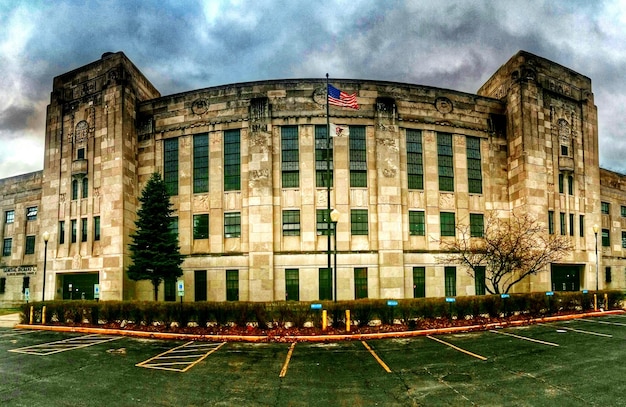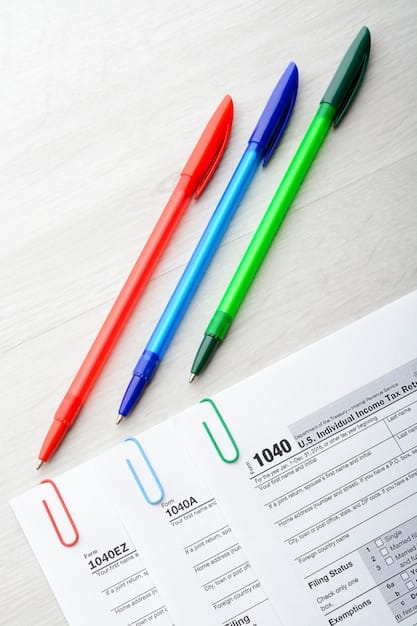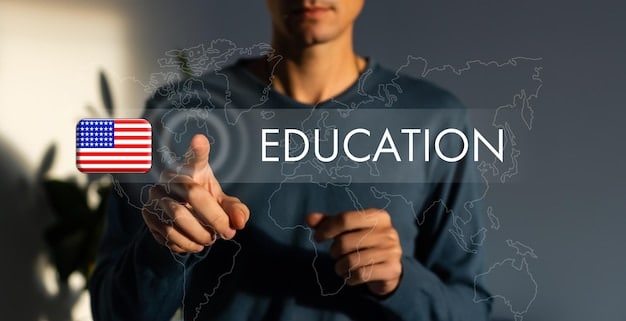Understanding Student Loan Forgiveness Guidelines 2025 in the US

Anúncios
Understanding the New US Department of Education Guidelines for Student Loan Forgiveness in 2025 involves navigating revised eligibility criteria, application processes, and potential benefits designed to assist borrowers struggling with student loan debt, aiming for a more accessible and equitable system.
Navigating the landscape of student loan forgiveness can be complex. As we look ahead to 2025, understanding the New US Department of Education Guidelines for Student Loan Forgiveness in 2025 is crucial for borrowers seeking relief from their student debt. This article breaks down the key aspects of these guidelines, helping you understand your eligibility and how to apply.
Anúncios
Introduction to the New Student Loan Forgiveness Guidelines
The US Department of Education is continuously working to refine and improve student loan forgiveness programs, focusing on making higher education more accessible and affordable. The guidelines set for 2025 reflect an ongoing effort to address the challenges faced by student loan borrowers, considering feedback from various stakeholders, including students, educators, and financial experts.
Anúncios
Key Objectives of the 2025 Guidelines
The primary objectives of the 2025 guidelines revolve around simplifying the forgiveness process and ensuring more borrowers can benefit from these programs. This includes adjusting eligibility criteria, streamlining the application process, and addressing potential loopholes or issues that have hindered previous forgiveness efforts.
- Expanding eligibility criteria to include a broader range of borrowers.
- Simplifying the application process to reduce administrative burdens.
- Enhancing transparency and communication to keep borrowers informed.
- Addressing disparities in forgiveness rates across different borrower demographics.
Understanding these objectives can help borrowers better prepare and navigate the forgiveness process, increasing their chances of successfully obtaining loan forgiveness.
In conclusion, the new guidelines from the US Department of Education point to positive changes for borrowers looking to gain relief from their student loans.
Eligibility Requirements for Student Loan Forgiveness
One of the most critical aspects of the new guidelines is understanding the updated eligibility requirements. Not all borrowers qualify for student loan forgiveness, and meeting the specific criteria is essential for a successful application. The 2025 guidelines have made some significant changes to who can apply and what conditions they must meet.

Income-Driven Repayment Plans and Forgiveness
Income-Driven Repayment (IDR) plans are a key pathway to student loan forgiveness. These plans adjust your monthly payments based on your income and family size. After a set number of years (typically 20 or 25), the remaining balance is forgiven.
The 2025 guidelines may adjust the terms of IDR plans, affecting the income percentage used for payment calculations and the total repayment period before forgiveness. These changes could make IDR plans more attractive and accessible for borrowers with lower incomes.
Public Service Loan Forgiveness (PSLF) Program
The Public Service Loan Forgiveness (PSLF) program is designed for borrowers employed by government organizations or qualifying non-profits. To be eligible for PSLF, borrowers must make 120 qualifying monthly payments while working full-time for a qualifying employer.
- The 2025 guidelines aim to clarify eligible employment and streamline the certification process.
- Temporary changes may be made to address past issues with PSLF eligibility and processing.
- Borrowers with previously denied PSLF applications should review the new guidelines carefully, as they may now qualify.
Essentially the eligibility requirements are designed to make the process easier for the borrowers, and to expand the people who can apply for student loan forgiveness.
How to Apply for Student Loan Forgiveness in 2025
The application process for student loan forgiveness can seem daunting, but understanding the steps involved can help ensure a smooth experience. The 2025 guidelines emphasize a streamlined and user-friendly application process.
Gathering Necessary Documentation
Before starting the application, gather all required documentation. This typically includes:
- Proof of income (e.g., tax returns, pay stubs)
- Documentation of eligible employment (for PSLF)
- Loan account statements
- Any other documents specified by the Department of Education
Ensuring you have all the necessary documents beforehand will save time and prevent delays in processing your application.
Submitting Your Application Online
The Department of Education is encouraging online application submission to speed up processing times and reduce paperwork. The online portal will guide you through each step, helping you complete the form accurately.
Make sure all information is accurate, and double-check your entries before submitting. Errors can lead to delays or even denial of your application.

Following Up and Staying Informed
After submitting your application, it’s important to follow up and stay informed about its status. The Department of Education will provide updates through email or the online portal.
Be prepared to provide additional information or documentation if requested. Regularly check your email and loan account for any notifications.
In closing, the application process for student loan forgiveness can be made much easier if the borrowers prepare all their forms, and follow up when needed.
Potential Benefits and Outcomes of the New Guidelines
The updated guidelines for student loan forgiveness in 2025 are expected to bring significant benefits to borrowers and the broader economy. These potential outcomes are designed to provide financial relief and promote economic stability.
Reduced Financial Burden for Borrowers
One of the most direct benefits is a reduction in the financial burden for borrowers. Through expanded eligibility and simplified processes, more individuals will have the opportunity to have their student loans forgiven.
This can lead to increased disposable income, allowing borrowers to invest in their futures, purchase homes, start families, and contribute to the economy.
Economic Impact and Social Equity
Student loan forgiveness can have a positive impact on the economy as a whole. By freeing up borrowers’ finances, it stimulates spending and investment. Moreover, it can address issues of social equity by providing relief to those who have been disproportionately burdened by student loan debt.
- Increased consumer spending
- Reduced rates of default
- Enhanced economic mobility
- Promotion of social justice and equality
Through these elements, the new guidelines can effectively offer financial relief, but also encourage economic stability and equal opportunity.
Common Mistakes to Avoid When Applying
Applying for student loan forgiveness can be complex, and it’s easy to make mistakes that could jeopardize your application. Understanding and avoiding these common pitfalls is crucial to ensure a successful outcome.
Inaccurate or Incomplete Information
Providing inaccurate or incomplete information is one of the most frequent mistakes. Always double-check all details before submitting your application.
Ensure that your income information, employment history, and loan account details are accurate and match the documents you provide.
Missing Deadlines
Missing deadlines can result in your application being denied. Keep track of all deadlines and submit your application and required documents on time.
Set reminders and regularly check for updates from the Department of Education to avoid missing any important dates.
Failure to Understand Eligibility Requirements
Applying for forgiveness without fully understanding the eligibility requirements is another common mistake. Carefully review the guidelines and ensure that you meet all criteria before applying.
If you’re unsure about your eligibility, seek guidance from a financial advisor. They may be able to help you with the process and make sure you dont make any mistakes.
Resources and Support for Student Loan Borrowers
Navigating student loan forgiveness can be challenging, but numerous resources and support systems are available to assist borrowers. Taking advantage of these resources can make the process smoother and more manageable.
Official Government Resources
The US Department of Education offers a wealth of information and resources on its website. This includes detailed explanations of forgiveness programs, eligibility requirements, application instructions, and FAQs.
The Department of Education’s website is a definitive source for accurate and up-to-date information.
Non-Profit Organizations and Financial Advisors
Several non-profit organizations provide free or low-cost counseling and guidance to student loan borrowers. These organizations can help you understand your options, navigate the application process, and manage your student debt.
- The National Foundation for Credit Counseling (NFCC)
- The Institute of Student Loan Advisors (TISLA)
These resources can provide valuable support, ensuring you make informed decisions about your student loans.
| Key Point | Brief Description |
|---|---|
| 📝 Eligibility Criteria | Revised requirements may include income, employment, and loan type. |
| 💻 Application Process | Streamlined online applications with clear documentation guidelines. |
| ✅ Potential Benefits | Reduced debt, improved credit, and economic benefits for borrowers. |
| 🛡️ Mistakes to Avoid | Inaccurate info, missed deadlines, and not understanding requirements can hinder your application. |
FAQ Section
▼
The 2025 guidelines aim to broaden eligibility, simplify the application process, and improve communication. They also try to address concerns about the fairness of the loan forgiveness system so far.
▼
Eligibility varies based on the program (e.g., IDR, PSLF). Common factors include income, employment type, and loan type. You should carefully look at the details for each path.
▼
Applications are generally submitted online through the Department of Education’s website. Be sure to gather all required records, fill in the forms completely, and meet required deadlines.
▼
You’ll typically need proof of income (tax returns), documents displaying eligible places of employment (for PSLF), and records of any active student loan accounts in your name.
▼
Official government resources, non-profits, and a financial counselor can provide the specifics that you need. They’re there to offer a helping hand whenever you need it.
Conclusion
Understanding the New US Department of Education Guidelines for Student Loan Forgiveness in 2025 is crucial for borrowers seeking relief from student debt. By staying informed, preparing thoroughly, and seeking support when needed, you can navigate the forgiveness programs effectively and improve your financial future.